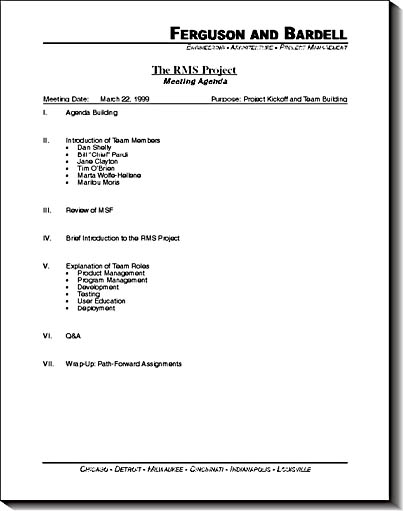Agenda Overview
"First of all," Dan continued, "let's look at some elements that may be new to you. Three items on this agenda will be on every meeting agenda for this project. The first is Agenda Building. This is an opportunity, right at the beginning of the meeting, for the team to adjust the agenda as it sees fit. Normally, I will construct and distribute an initial agenda a few days before a team meeting. It's possible—indeed, likely—that you will want to discuss items that I either don't know about or that I forgot to include. So, the Agenda Building item is your chance to add or subtract items from the agenda as a team.

"At the end of the agenda, there will always be questions and answers. This is your last chance for clarification or information before we move to the Wrap-Up item. Your questions do not have to be about items on the agenda, but they do have to relate to the project and be pertinent to the group. We don't want to waste team members' time with questions about other projects or with specifics about this project that the team as a whole is not involved in.
"The final item on the agenda will always be the Wrap-Up. This is where we recap any decisions we made in the meeting and make sure everyone is clear on what we did. This is also where we confirm any assignments made during the meeting, along with deadlines. You'll notice I use the term Path-Forward Assignments. It may be that during a meeting we will have to analyze a situation, possibly taking apart a problem and figuring out what went wrong. That's okay; we need to learn from our mistakes. At the end of the meeting, though, we want to focus on where we go from here. What is our path forward for the current project? What are our immediate next steps? That's how we want to conclude our meetings. Any questions?"
At this first meeting, no one wanted to be the first to ask a question, so Dan pressed ahead. "Does anyone have any adjustments to the agenda that they would like to propose?" Everyone looked around the table to see who might be the first to break the ice. Finally, Marta raised her hand slowly.
"Pardon me, Mr. Shelly, but in your opening remarks you mentioned how important this project is to the company, and how visible it will be. I appreciate the invitation to be a part of the project team, but I'm not sure why I'm here. Might it be worthwhile to add an agenda item for you to explain why each of us has been included?"
"First of all, Marta, it's Dan, not Mr. Shelly. Secondly, your question is an excellent one. My plan is to match up team members with roles in item 5 on the agenda, where I think it will become clear why each of you is on the team. Does that work for you?" With another small smile, Marta nodded, and Dan looked at the others around the table. "How about the rest of you? Does it make sense to you to proceed this way?" Everyone nodded in agreement. Tim leaned over to Marta and whispered loudly, "Thanks for asking, Marta. I was wondering the same thing, but the last time I asked a question in a meeting, I got made project lead!" Everyone laughed, and the tension level in the room dropped noticeably.
Dan turned to Jane. "Jane, why don't you move us into our next agenda item by introducing yourself? We'll just go around the table. Tell us your title, how long you've been at Ferguson and Bardell, and what your responsibilities are." He looked at the rest of the team. "We six are going to be working closely together over the next couple of months, so the sooner we get to know one another, the better. Start now to get a good sense of each other's abilities, as well as each other's blind spots. To be a good team, we'll want to use each person's strengths and help each person work around their weaknesses and preconceptions. Honest communication is a must, so begin by listening and learning as we do the introductions." He turned back to Jane. "Okay, Jane, tell us all about yourself."
EAN: N/A
Pages: 182